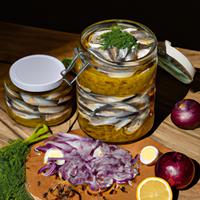
1 serving (100 grams) contains 262 calories, 25.0 grams of protein, 18.0 grams of fat, and 0.0 grams of carbohydrates.

Log this food in SnapCalorie

Nutrition Information
Calories |
623.8 | ||
|---|---|---|---|
% Daily Value* |
|||
| Total Fat | 42.9 g | 55% | |
| Saturated Fat | 10 g | 50% | |
| Polyunsaturated Fat | 0 g | ||
| Cholesterol | 183.3 mg | 61% | |
| Sodium | 2071.4 mg | 90% | |
| Total Carbohydrates | 0 g | 0% | |
| Dietary Fiber | 0 g | 0% | |
| Sugars | 0 g | ||
| protein | 59.5 g | 119% | |
| Vitamin D | 1619.0 mcg | 8095% | |
| Calcium | 135.7 mg | 10% | |
| Iron | 2.6 mg | 14% | |
| Potassium | 778.6 mg | 16% | |
* Percent Daily Values are based on a 2,000 calorie diet. Your daily values may be higher or lower depending on your calorie needs.
Food Attributes
Source of Calories
About Salted herring in brine
Salted herring in brine is a preserved fish product commonly found in Scandinavian, Eastern European, and Dutch cuisines. It consists of fresh herring fillets soaked in a saltwater solution, often with added spices or vinegar, which enhances flavor and improves shelf life. This preparation method dates back centuries as an efficient way to store and transport seafood. Rich in protein and omega-3 fatty acids, salted herring supports heart health, brain function, and inflammation reduction. It is also a good source of essential minerals like selenium and vitamin D. However, its high sodium content requires moderation, as excessive salt intake may contribute to high blood pressure and water retention. Typically consumed as part of appetizers, salads, or served with potatoes and bread, salted herring is both flavorful and nutritious, reflecting the traditions of coastal communities where fish has long been a dietary staple.



